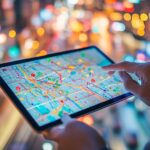In today’s competitive retail landscape, understanding customer behavior is essential for business success. Foot traffic data provides valuable insights into consumer habits, revealing patterns that can help businesses strategically plan their operations. This article explores the concept of foot traffic data and its significance, highlights how it can identify seasonal shopping trends, and showcases examples of businesses that have effectively utilized this information. Additionally, we discuss the challenges associated with using foot traffic data and offer tips for overcoming these hurdles to maximize its benefits.
Understanding Foot Traffic Data

Foot traffic data is crucial for estimating consumer behavior, shopping patterns, and visit frequency. The term “foot traffic” refers to the measurement of footfall metrics, providing insights for visitation rates, shopper engagement, and store performance. Additionally, it aids in understanding shopping habits and traffic measurement techniques.
Advanced analytics tools, including real-time analytics and data visualization, combined with location intelligence, allow retailers to analyze traffic patterns in relation to sales performance metrics across various shopping seasons. Additionally, foot traffic data can inform marketing decisions. By analyzing seasonal trends, customer demographics, and purchasing behavior, retailers can optimize their promotional strategies, ultimately improving profitability through effective retail analytics and customer journey mapping.
What is Foot Traffic Data?
Foot traffic data quantifies the number of individuals visiting a physical location, making it essential for understanding visitor patterns, shopping behavior, and geographical data. This data is collected through methods such as mobile tracking, sensor technology, and point-of-sale data, enabling a comprehensive measurement of footfall and providing demographic insights crucial for data analysis.
These metrics, including visit frequency and shopper demographics, are crucial for businesses aiming to enhance location intelligence and optimize customer engagement, ultimately improving retail performance and sales conversion rates.
Advanced analytics tools give the power to retailers to analyze trends over time, identify peak visit times and shopping days, and assess the effectiveness of various marketing campaigns. Key metrics like dwell time and return visits are vital for evaluating shopping behavior, which can inform inventory decisions, customer footfall analysis, and enhance the overall shopping experience for customers through optimized marketing and promotional campaigns.
Moreover, foot traffic data goes beyond merely counting visitors; it enables businesses to make strategic decisions regarding staffing, store layouts, promotional activities, and inventory management, all of which contribute to overall retail performance. By effectively leveraging this data, businesses can engage in more strategic planning and better resource allocation, providing a competitive advantage in the rapidly evolving retail landscape through insights into season-specific marketing and trend forecasting.
Why is it Important for Businesses?

The significance of foot traffic data for businesses lies in its ability to provide insights into customer behavior and shopping motivations, enabling data-driven decision-making. Retail analytics is employed to assess store performance, optimize traffic conversion rates, enhance promotional initiatives, and engage in market research, thereby improving customer experiences and brand awareness.
Insights derived from foot traffic data can refine market segmentation and customer segmentation, leading to more targeted marketing strategies. For instance, a large coffeehouse chain utilized foot traffic data to identify peak hours and adjusted staffing accordingly, resulting in shorter wait times, improved service efficiency, and increased customer satisfaction.
Similarly, an apparel retailer used location-based analytics and behavioral insights to evaluate the effectiveness of promotional displays and discovered a correlation between foot traffic spikes and specific marketing campaigns, enhancing retail strategies through improved visual merchandising and promotional strategies.
These examples illustrate the importance of foot traffic data for businesses, highlighting how it can be leveraged to enhance operational efficiency and align offerings with consumer behavior.
Identifying Seasonal Shopping Trends
Retailers analyze seasonal shopping trends identified through foot traffic data to assess changes in consumer behavior and shopping patterns throughout the year. This data offers valuable insights into how seasonal sales, economic indicators, and macroeconomic factors influence shopper profiles and purchasing habits, aiding in trend identification and seasonality effects analysis.
With this knowledge, companies can adjust their marketing strategies and optimize inventory management to align with demand trends during different shopping seasons and seasonal promotions, ensuring effective data-driven marketing and inventory turnover strategies.
How Foot Traffic Data Can Help

Retailers utilize foot traffic data for predictive analytics, sales forecasting, and insights into consumer trends and market dynamics. By analyzing past foot traffic patterns and shopper demographic information, retailers can enhance their demand forecasts and align their inventory and sales strategies accordingly, improving business intelligence and retail trends understanding.
This approach enables retailers to gain a clearer understanding of peak demand periods, peak shopping times, and implement additional promotional strategies to boost foot traffic and shopper engagement during busy times, enhancing their competitive analysis and customer engagement efforts.
Additionally, leveraging foot traffic data allows retailers to conduct behavioral analytics, providing valuable insights into customer behaviors, preferences, shopping patterns, and purchase behavior. By understanding these patterns, retailers can better curate their product assortments and optimize store layouts to emphasize popular items, ultimately improving the shopper journey and customer preferences alignment.
Furthermore, foot traffic patterns can be correlated with social media engagement, event marketing, and local events to identify factors that influence consumer interest. By analyzing these metrics, retailers can discern what motivates shoppers to visit their stores and develop more effective and personalized marketing campaigns and strategies, fostering loyalty programs and enhancing shopping experiences.
Using Foot Traffic Data to Improve Business Strategies
The effective utilization of foot traffic data can enhance business strategies, particularly in marketing analytics, customer experience, and retail strategies. Leveraging this data assists in optimizing traffic sources and seasonal demand management.
Retailers gain valuable insights into their traffic sources, shopper demographics, and consumer insights, enabling them to improve advertising effectiveness and optimize sales strategies. This data empowers businesses to innovate their retail approaches with big data and real-time analytics, ensuring they adapt to the evolving preferences and demands of their customers through omnichannel retailing and click-and-mortar strategies.
Examples of Successful Implementation

Many businesses have successfully utilized foot traffic data to drive retail innovations, enhance customer loyalty, and increase brand awareness. Case studies demonstrate how companies have leveraged foot traffic information to improve experiential retail environments that attract customers and encourage repeat visits, ultimately improving customer retention and loyalty programs.
For instance, this can be achieved by integrating foot traffic data with omnichannel shopping strategies, creating an end-to-end customer journey that aligns with modern shopping habits and online shopping trends, effectively bridging offline shopping with digital engagement.
One leading apparel brand redesigned its flagship store using foot traffic analytics and customer footfall data to create a welcoming atmosphere that allowed customers to interact with products and participate in live demonstrations. This enhancement of the in-store experience fostered a stronger emotional connection with shoppers, resulting in a significant increase in customer retention and improved shopping motivations.
Another retailer effectively implemented real-time foot traffic data and sales trends analysis to develop staffing schedules tailored to busy hours, thereby improving service efficiency and customer satisfaction, demonstrating effective use of retail strategies and economic factors consideration.
This alignment of data-driven decision-making with experiential retail reflects current consumer trends toward personalized and engaging shopping experiences, encompassing seasonality and trend identification in the retail environment.
Challenges and Limitations of Foot Traffic Data
The challenges and limitations associated with foot traffic data, including the accuracy of data collection methods, biases inherent in analytical tools, and concerns regarding data privacy, can significantly impact the reliability of insights derived from measuring foot traffic. Addressing these issues is crucial for effective data collection and analysis, ensuring reliable consumer insights and retail performance evaluation.
A comprehensive understanding of these challenges is beneficial for businesses that aim to utilize foot traffic data, traffic optimization, and conversion rates analysis while ensuring compliance with data privacy regulations such as GDPR and CCPA.
Potential Issues and How to Overcome Them
Potential issues related to foot traffic data often arise from concerns regarding the accuracy of the data, analytics tools effectiveness, and data analysis reliability. To ensure data accuracy and comply with privacy regulations, businesses must employ robust data collection methods and invest in reliable analytics solutions to support marketing effectiveness and sales analysis.
Additionally, implementing clear protocols for data management and business intelligence can enhance the overall effectiveness of foot traffic analysis, ensuring optimized marketing strategies and traffic fluctuations management.
These challenges can be addressed by utilizing user-friendly and regularly updated data collection tools, such as mobile GPS, mobile analytics, Bluetooth, or motion sensors. These tools collect data at intervals that align with their processing speed, ensuring that foot traffic insights are accurate and beneficial for sales forecasting and store location optimization.
Wi-Fi tracking, mobile location services, and beacons can provide valuable data on foot traffic, visit frequency, and engagement metrics while adhering to data privacy legislation, such as the GDPR or CCPA, supporting the shopper journey and seasonal demand management.
A 2018 study published in the Journal of Computer and System Sciences examined the privacy risks associated with location-based services and found that the number of individuals whose privacy is compromised, as well as the severity of the risk, can be reduced through various techniques. These techniques include data-driven marketing and other privacy-enhancing strategies:
- Anonymization
- Aggregation
- Limiting the spatial and temporal resolution of geographic footprints
The technology that facilitates this location-based information can be integrated via mobile apps, public Wi-Fi networks, or physical beacons in stores. This technology can then be analyzed to uncover foot traffic patterns, traffic trends, and geographical data, supporting market segmentation and shopper profiles analysis.
Plus technological solutions, training employees on the importance of consumer data privacy and security practices is essential to promote a culture of privacy awareness. Organizations should also routinely evaluate and adjust their protocols as necessary to comply with changing regulations, thereby maintaining customer trust while utilizing foot traffic data to generate actionable insights, enhance holiday shopping and shopping events strategies, and prepare for seasonality effects.






